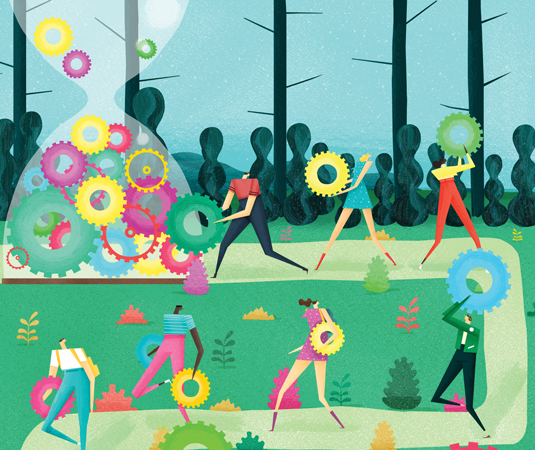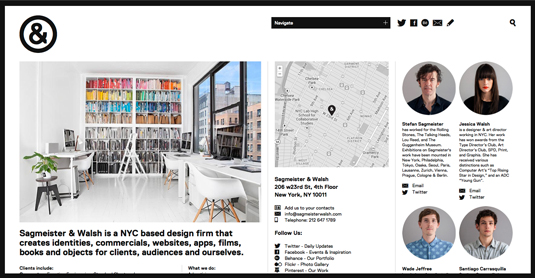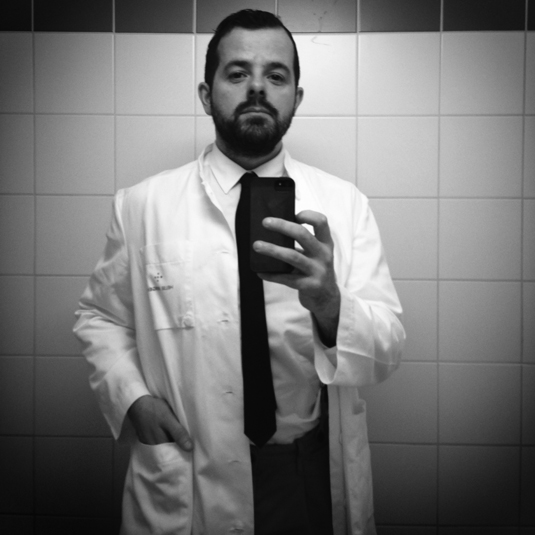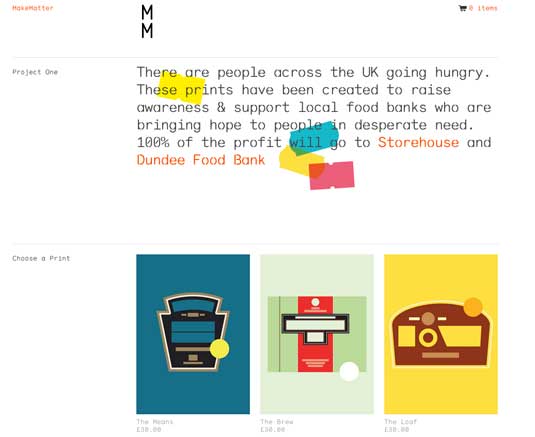How to make your downtime work for you
Downtime doesn’t need to be wasted time – we spoke to four creatives who turned their free hours into something equally as fulfilling and creatively productive as their day jobs.

Work to live or live to work? For many designers this isn't a relevant question: even if they weren't earning a living from their creative endeavours, they'd probably be pursuing them anyway. Having a job which also happens to be your main passion in life is, of course, a blessing.
But if you're not careful, it could turn out to be something of a curse too, as you might find yourself filling every waking hour with work. While it can sometimes be difficult to say no to paid work - especially if you're a freelancer - ensuring that you have some time to focus on your own projects, experiment with new ideas, or just do nothing at all, is vital for wellbeing and creativity. This is perhaps even more important when the downtime doesn't come through choice. So how do other designers fill their downtime creatively?
Famously, Stefan Sagmeister took the decision to close down his studio every seven years and take a year off on sabbatical. "I thought it might be helpful to cut off five retirement years and intersperse them with working years," he explained in a talk for TED. "That's clearly important for myself, but probably even more important is that the work that comes out of those years flows back into the company and into society at large."
I thought it might be helpful to cut off five retirement years and intersperse them with working years
As an example to prove that downtime or holiday doesn't necessarily equate to 'wasted' time, he pointed out that global corporation 3M allows its engineers 15 per cent of their paid, working time to pursue projects of their own. It was as a result of just such periods that two of the company's most successful products - Scotch tape and sticky notes - were developed. The same is true of design. Ultimately, Sagmeister said, everything his studio designed in the seven years following his first sabbatical originated in that year off.

Few people have the luxury of being able to take off a year at time, of course, but downtime doesn't have to be as radical as that. one thing that is certain is the importance of having some in the first place. While that may seem obvious, there's a certain breed of designer - the freelancer in particular - to whom the thought is anathema.
You can see it on their blogs and Twitter feeds: almost boasting that they get only five hours' sleep, talking to international clients in the middle of the night, complaining that they never have a free moment, and so on. of course, this is understandable. Freelancers need to appear to be busy at all times, if only to prove they're successful for their clients - but it's when this is carried to extremes that the possibility of burnout and plain old exhaustion becomes very real.
A labour of love
This is a subject that's very close to the heart of Steve Price of plan-B Studio, who is himself self-employed and has taken a stand against increasing workloads for decreasing money.
Daily design news, reviews, how-tos and more, as picked by the editors.
"I know freelancers working 18-hour days, week-in, week-out," he says. "There's often [an attitude of] 'put up and shut up', or a fear of not being invited back. The same has often happened with clients, and projects of my own. There's no charm in constantly being 'too busy'. It projects a lack of personal and professional time management; the same is true of clients."
As a result, price has consciously done the opposite of what might be expected. He's put up his day rate and will not take on any job he feels asks too much of his time for too little reward, or where he thinks the clients might become too demanding.

As he admits, it's been hard: "Those with whom I would have worked for free before, who did sometimes commission me, no longer call," he gives as one example. On the other hand, his personal life and productivity have been massively enriched.
"I work less. I live more. I'm healthier than I've ever been and my ideas, work and outlook have never been richer," he enthuses. "I sketch more, I write more. I think more. I earn less. I've gotten used to saying 'I've never been poorer yet spiritually richer', which sounds egotistical, whimsical and vomit-inducing. Apologies, I hate myself too..."
Staying afloat
Boat Magazine is a perfect example of what can happen when a project born through downtime grows into something much bigger. Boat is a biannual travel and culture publication that travels to a different international city for each issue and invites writers, photographers and artists to contribute their ideas on what makes the place unique. So far it has visited the likes of Detroit, london, Athens and reykjavik.
But Boat isn't really a travel magazine - it's a labour of love, launched by Davey Spens and his wife Erin, of Boat Studio. In a slow period in its first year, the studio made the decision that while its clients were off on their winter breaks, it would use the free time productively to "embark on a project, or go on an adventure", as Davey Spens explains. The pair decided to travel to Sarajevo.

At that time, they could find very little information about the city, beyond rather hackneyed images of the recent war. So they hired a house and invited locals to talk about their stories, and once back in England, turned these into a magazine.
"It certainly wasn't screamingly commercial," says Spens. "A biannual publication, with an unhelpful name, very broad content areas focused on a very specific subject - and then there's factoring in the travel costs and the time we spend in the field, when we can't work on paying-client projects." But the point, he says, was to do something different, to create something outside of the studio's normal work and free from convention.
By Boat's own reckoning, 50 per cent of its time as a studio is spent working on the magazine (indeed, half the team work on it full-time now), yet it contributes only 7 per cent to its turnover. So why bother? "It's been good at bringing amazing people across our path," says Spens
It has brought in a few new projects. It also makes our studio happier. It's happy-making
"It has brought in a few new projects - though not that many - and it's a blank canvas for us to make something we're really passionate about. It also makes our studio happier. It's happy-making."
Creating, printing and publishing a self-funded, 112-page magazine from scratch every six months might not be everyone's idea of 'happy-making', but the point is that no matter how fulfilling your job might be, you need a complementary activity to get away from it now and then.
Worthy causes
Ed Watt decided to channel his creativity into trying to make a real difference in society - although, as was the case with Boat, the project startedalmost by accident. He's the founder of MakeMatter, which aims to match creative projects with worthwhile causes.
A creative director at O Street design agency in Glasgow and a contributor to FormFiftyFive, Watt was recently asked to exhibit some work for Nomas projects in Dundee. "It's a unique mini-gallery format of four windows displaying directly onto the street, accompanied by a talk," he explains. "I loved the idea of getting art out of the gallery and felt that simply showing off or repurposing my commercial work wasn't really appropriate.
"At the same time, I was utterly shocked by the stories I'd heard that had led my church to open a food bank called Storehouse, dismayed at the welfare cuts and just motivated to do something to help." Thus the gallery became a window shop selling original work by Watt, with profits going to the Storehouse and Dundee Food Bank.

It's the first of what he hopes will be an ongoing series of projects involving other designers. "Some excellent designers and creatives have been in touch to say they would like to be involved, and I'm just considering what to do next," he adds. "So if you are reading this and it's sparked off a little idea, just drop me a line..."
MakeMatter has proven to be much more time-consuming than Watt anticipated - to the point where he's now working four days a week with o Street, and one on MakeMatter. As well as the help this will bring to charities, Watt has found other benefits from his side project.
MakeMatter made me realise that my instinct is often the best decision maker. Don't dwell. Just do.
"I now have to get all my other work done in four days - which sounds like a negative, but it's good just for developing discipline," he says. "It's made me realise that my instinct is often the best decision maker. Don't dwell. Just do. Try it, then come back and craft it."
As all of these inspiring projects demonstrate, downtime - whether it's enforced or otherwise - needn't be a creative dead-end or wasted time and indeed in many cases can lead to whole new avenues of thought. As Steve price comments, "No one is indispensable - the world will not stop if you leave for two weeks. Also, without taking a proper break how can you expect to be anywhere near the top of your game?"
Words: Ed Ricketts
This article originally appeared in Computer Arts issue 222.
Liked this? Read these!
- Create a perfect mood board with these pro tips
- The ultimate guide to logo design
- Our favourite web fonts - and they don't cost a penny

The Creative Bloq team is made up of a group of art and design enthusiasts, and has changed and evolved since Creative Bloq began back in 2012. The current website team consists of eight full-time members of staff: Editor Georgia Coggan, Deputy Editor Rosie Hilder, Ecommerce Editor Beren Neale, Senior News Editor Daniel Piper, Editor, Digital Art and 3D Ian Dean, Tech Reviews Editor Erlingur Einarsson, Ecommerce Writer Beth Nicholls and Staff Writer Natalie Fear, as well as a roster of freelancers from around the world. The ImagineFX magazine team also pitch in, ensuring that content from leading digital art publication ImagineFX is represented on Creative Bloq.
